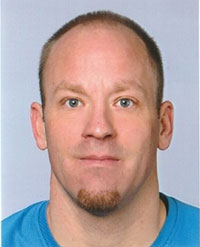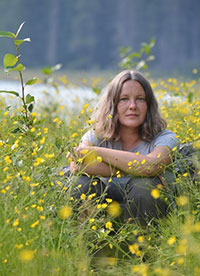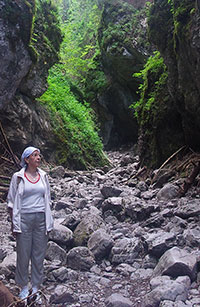 Zbigniew M. Bochenski. Institute of Systematics and Evolution of Animals, Polish Academy of Sciences, Slawkowska 17, 31-016 Krakow, Poland. (corresponding author) bochenski@isez.pan.krakow.pl
Zbigniew M. Bochenski. Institute of Systematics and Evolution of Animals, Polish Academy of Sciences, Slawkowska 17, 31-016 Krakow, Poland. (corresponding author) bochenski@isez.pan.krakow.pl
Zbigniew M. Bochenski graduated from the Jagiellonian University, Kraków, Poland in 1987 and received his PhD in 1994. He has been working at the Institute of Systematics and Evolution of Animals, Polish Academy of Sciences, Kraków, Poland since 1987. He divides his research activity between fossil and modern bird remains. He has published a number of papers on avian taphonomy, fossil and archaeological bird remains, and several works on the comparative osteology of modern birds. He was the recipient of three major one-year each scholarships, which helped him gain professional experience in other academic centers, including Germany, Switzerland and the USA.

 Teresa Tomek. Institute of Systematics and Evolution of Animals, Polish Academy of Sciences, Slawkowska 17, 31-016 Krakow, Poland. tomek@isez.pan.krakow.pl
Teresa Tomek. Institute of Systematics and Evolution of Animals, Polish Academy of Sciences, Slawkowska 17, 31-016 Krakow, Poland. tomek@isez.pan.krakow.pl
Teresa Tomek graduated from the Jagiellonian University, Kraków, Poland in 1967 and received her PhD in 1976. She worked at the Institute of Systematics and Evolution of Animals, Polish Academy of Sciences, Kraków in 1971-2017; currently she is a volunteer there. She published more than 60 scientific papers on various aspects of ornithology, paleontology and comparative osteology of birds. Teresa took part in eight ornithological expeditions to the Democratic People's Republic of Korea.

 Krzysztof Wertz. Institute of Systematics and Evolution of Animals, Polish Academy of Sciences, Slawkowska 17, 31-016 Krakow, Poland. wertz@isez.pan.krakow.pl
Krzysztof Wertz. Institute of Systematics and Evolution of Animals, Polish Academy of Sciences, Slawkowska 17, 31-016 Krakow, Poland. wertz@isez.pan.krakow.pl
Krzysztof Wertz graduated from the Jagiellonian University with a degree in biology in 2006. He works at the Institute of Systematics and Evolution of Animals, Polish Academy of Sciences as a biologist and curator of the bird comparative collection. He has been participating in a number of scientific projects, including archaeological excavations and descriptions of new species. He often refers to himself in the third person.

 Johannes Happ. Department of Palaeontology, Faculty of Earth Sciences, University of Vienna, Vienna, Austria. johanneshapp@yahoo.de
Johannes Happ. Department of Palaeontology, Faculty of Earth Sciences, University of Vienna, Vienna, Austria. johanneshapp@yahoo.de
Johannes Happ received his BA, in general biology, from the University of California, at Santa Cruz, U.S.A. in 2001. He received his MSc in Palaeobiology in 2014 from the University of Vienna, Austria and is currently working on his PhD at the University of Vienna, Austria. Since 2001 he is working as a biologist at a reptile-zoo in Klagenfurt, southern part of Austria.

 Małgorzata Bujoczek. Department of Forest Biodiversity, Faculty of Forestry, University of Agriculture, al. 29 Listopada 46, 31-425 Krakow, Poland. malgorzata.bujoczek@urk.edu.pl
Małgorzata Bujoczek. Department of Forest Biodiversity, Faculty of Forestry, University of Agriculture, al. 29 Listopada 46, 31-425 Krakow, Poland. malgorzata.bujoczek@urk.edu.pl
Małgorzata Bujoczek graduated from the University of Agriculture, Kraków, Poland in 2005 and received her PhD in 2011. Her research includes biology and ecology of modern birds, protection of bird habitats, especially forest habitats. Her specialization is identification of feathers and their application in research. Many of her works are based on information contained in feathers. As a ringer she is a co-worker of the Polish Ringing Centre.

 Ewa Swidnicka. Department of Palaeozoology, Institute of Environmental Biology, Faculty of Biological Sciences, University of Wrocław, Sienkiewicza 21, 50-335 Wrocław, Poland. gama@biol.uni.wroc.pl
Ewa Swidnicka. Department of Palaeozoology, Institute of Environmental Biology, Faculty of Biological Sciences, University of Wrocław, Sienkiewicza 21, 50-335 Wrocław, Poland. gama@biol.uni.wroc.pl
Ewa Swidnicka graduated from the Adam Mickiewicz University in Poznań with master’s studies degree in the field of Earth Sciences in 1978. She gained paleontological experience under the direction of a paleontologist Professor Anna Jerzmańska in the Department of Palaeozoology, University of Wrocław. She is a co-author of a number of scientific articles, mostly on fossil fishes, birds and also insects including a monographic work on fossil fishes from the Oligocene-Miocene deposits based on about 200 exposures from the Polish Flysch Carpathians. Although she has already retired, Ewa is still working on paleontological materials from the outcrops of Paleogene and Neogene sediments in the Polish Carpathians.

